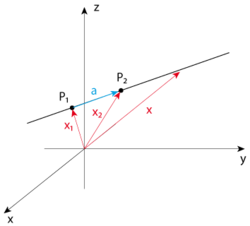Calculus/Curves and Surfaces in Space
Introduction
For many practical applications, for example for describing forces in physics and mechanics, you have to work with the mathematical descriptions of lines and planes in 3-dimensional space.
Parametric Equations
Line in Space
A line in space is defined by two points in space, which I will call and . Let be the vector from the origin to , and the vector from the origin to . Given these two points, every other point on the line can be reached by
where is the vector from and :
Plane in Space
The same idea can be used to describe a plane in 3-dimensional space, which is uniquely defined by three points (which do not lie on a line) in space (). Let be the vectors from the origin to . Then
with:
Note that the starting point does not have to be , but can be any point in the plane. Similarly, the only requirement on the vectors and is that they have to be two non-collinear vectors in our plane.
Vector Equation (of a Plane in Space, or of a Line in a Plane)
An alternative representation of a Plane in Space is obtained by observing that a plane is defined by a point in that plane and a direction perpendicular to the plane, which we denote with the vector . As above, let describe the vector from the origin to , and the vector from the origin to another point in the plane. Since any vector that lies in the plane is perpendicular to , the vector equation of the plane is given by
In 2 dimensions, the same equation uniquely describes a Line.
Scalar Equation (of a Plane in Space, or of a Line in a Plane)
If we express and through their components
writing out the scalar product for provides us with the scalar equation for a plane in space:
where .
In 2d space, the equivalent steps lead to the scalar equation for a line in a plane:





















